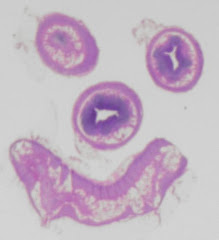I know that this may be hard to believe for many PAs elsewhere in Canada, but this past week marked a milestone here in the Interior Health Authority's gross rooms. The first Okanagan-wide surgical pathology (for grossing) procedures were distributed. So much effort since spring, 2005 has gone into just keeping our heads above water that progress has been terribly slow at times (and for this I apologize). Manpower levels are beginning to get to the point where gradual improvements can now be made. These 'in-brief' procedures, and all submitted in the future, will improve our ability to meet the requirements of the soon-to-be-implemented quality management system in which the existence of policy and procedure manuals (and abiding by them) is a cornerstone. Standardization of methodology will result in an overall improvement in quality and consistency in surgical pathology. The pathologists' participation in the creation of procedures is absolutely necessary in order to guarantee an excellent product. Their input will be needed at the first round of revisions of the procedures, beginning in six months.
The next step is to consider, and to implement, gross description templates. This is a contentious issue for some pathologists who may not appreciate the power of templates to ensure a minimum level of quality; and to do so invisibly and seamlessly from their perspective. The transcriptionists, if a space in the template is mistakenly left blank, will interact with the PA so that the blank is filled in before the report and the slides find their way to the pathologist's desk. Issues surrounding concerns about PAs' grammar, vocabulary or accents become unnecessary as the templates are primarily in point form. Each template has a space where the PA may provide additional, free-text description, as necessitated by the each specimen's unique nature. Well-designed templates require very little additional description of this sort however. Templates, much like synoptic reports for diagnosis, answer all the necessary questions for both pathologist and oncologist; little more and no less. Superfluous, flowery, or unnecessary language is avoided. They are far easier, and far less time-consuming, to decipher than a traditionally-worded description. They have been in use at many other centres for many years and have been well received by PAs, transcriptionists, residents, oncologists and pathologists alike. Like procedures, gross description templates provide a quality assurance tool which improves our product.
The last step in the creation of the manual will be to make up the full-length policy and procedure documents. These will provide more information than the brief versions; will give the rationale behind various methods and will list references. Policy and procedure documents governing the general rules for handling specimens, safely, telepathology, photography and other gross room functions will also be written.
As Laboratory Medicine in the Interior Health Authority moves towards participation with The University of British Columbia Medical School, the manuals will be an excellent resource for training of medical residents in surgical pathology.
Other news...
A second PA is starting in Kelowna on the 15th of January. Considerable renovations are being effected in the near future to allow for a safe work space for the PA, to provide office space for more pathologists and a clinical microbiologist, and to improve work flow in the gross room for frozen sections, etc. One of our PAs is returning from parental leave tomorrow. Welcome back!
Wish us luck; our Meditech IT system is being upgraded (?improved). I'll reserve judgment on whether it'll be any more user-friendly than it is currently. So often, IT systems and "user-friendliness" seem to have a hard time co-existing.



No comments:
Post a Comment